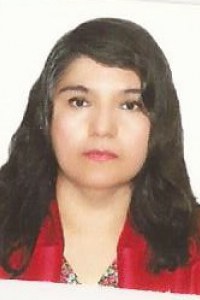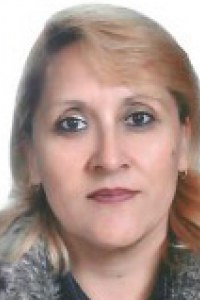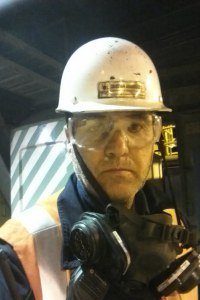
Marite Arija Bake, Anita Pike, Nina Rusakova, Sabine Grinberga, Svetlana Domkova
Institute of Occupational and Environmental Health of Riga Stradins University / 16 Dzirciema Street / Riga / LV-1007 Latvia+371 67409187 / Marite-Arija_Bake@rsu.lv
ABSTRACT
ABSTRACT
Stress and burn-out syndrome are new types of work risk factors today connected with development of work related diseases. Goal of the research is to develop criteria for early diagnosis of health disturbances in connection with work related stress.
200 health care workers were asked to evaluate psychosocial risk. Stress hormones cortisole and testosterone in saliva were detected three times per day.
High work load both physical and mental and relationship with superiors, colleagues and patients are determined as most important psychosocial risk factors for health care workers. The level of stress hormones in saliva is variable. The highest mean level of hormones reviled in midday which do not correspond to normal diurnal variations of hormones may be connected with stress.
Keywords
Keywords
Stress hormone, health care workers, and risk factors
INTRODUCTION
INTRODUCTION
The occupational health specialists started to investigate impact of psychosocial risk factors to workers’ health in the last decade and pointed out that psychosocial risk factors could negatively affect physical, psychological and social health of employees (Melamed, 1999; Fujiwara, 2004; Yang, 2001). The dissatisfaction with job and organisation of work activities, enlargement of work load, speeding-up of working pace, necessity to do more with minimum of investments as well as uncertainty on perspectives in current job give rise to stress at work. High level of the labour demands not corresponding to work experience provokes a classic stress situation and impossibility to be master of the situation, independent and creative at work from one side, and strong and irrational policy of administration from the other side make stress deeper. Social and psychological interactions in organization may be one of more important factors of professional burn out. Development of stress may be incriminated as the end result of impact of hazardous factors and situations. It is necessary to find out the informative and optimally applicable indicators of stress and criteria for evaluation of the situation concerning impact of stress on organism of workers. Salivary cortisol and testosterone represent a simple and non-invasive measure that can facilitate the study of hypothalamic-pituitary-adrenal (HPA-) axis activity and studies of effects of occupational stress. [1, 4, 5, 6, 9, 11].
Goal of the research is to develop criteria for early diagnosis of health disturbances in connection with work related stress.
MATERIALS AND METHODS
Burnout was evaluated by questionnaire consisting of 82 questions (prepared for local use in Latvia on basis of Finish Institute of Occupational Health experience). Questionnaire cover socio-demographic characteristics, profession, physical and mental work load, work organization, hazardous risk factors at work, psychological clime at work, satisfaction, self reported health disturbances (vital exhaustion, tension). Health care workers (n=200) were asked to evaluate psychosocial risk, but only 147 respondents (74%) answered and signed the agreement on participation. Respondents were asked to indicate how frequently they experienced such stressful situation. Each item was scored on five-point scale, ranging from 1 (never) to 5 (almost always) and for evaluation of stress divided in three subscales: non-stressed (never or seldom have risk), stressed (often or almost always have risk) and respondents having difficulties to answer or having risk sometimes. Questions are grouped in eight groups for evaluation most important risk factors for health care workers: workload (too much work to do and hurry, too many different things to do, not enough time to complete all tasks satisfactorily, not enough time for recreation), organizational structure and management at work (poor organizational structure and process, lack of relationship with supervisors, poor management and supervision, clear/unclear job tasks, lack of ways of solving conflicts in the organization), social supportfrom family, friends and colleagues, support and recognition from superiors and managers, relationship with colleagues (relations with colleagues, conflict with other professionals, psychological clime in department, inadequate interest from colleagues and slander), professional self-doubt (feeling inadequately skilled for dealing with difficult patients, possibility to use own skills and knowledge, regular dividing of job tasks, honest dividing tasks within group), threat from patients (dealing with difficult or demanding patients, physical and verbal threat from patients) and risk of infection (HIV, HBV, HCV, TBC etc.). Separately were evaluated emotional expression of stress, physiological expression of stress and self evaluation of health, satisfaction with work and life.
Saliva samples were collected three times during a single working day using Salivette® tampons, e.g., in the morning (8 – 9), at noon (12-13) and in the afternoon (16 – 17) for 3- to 5-minute period. Within investigation day samples were stored in a refrigerator until delivery to the laboratory. After centrifugation (15 minutes 3000 g) and removal of tampons sample were stored at -200C in original salivette containers till analysis. Stress hormones cortisole and testosterone in saliva were detected using immunofermentative method with ELISA test system (Diagnostics Biochem Canada Inc.: kit 052690 for testosterone in saliva and lot 070190 for cortisol in saliva). Hormones were detected in 30 respondents in two separate groups because received amount of saliva did not allow preparing of both measurements.
RESULTS
Results of questionnaires
Most respondents were females (87.8%), mean age of respondents 44.3 ± 12.0 years. Respondents were divided according to profession in four groups: doctors (18.4%), assistant of doctors (1.4%), nurses (42.2%), assistant of nurses or hospital attendant (12.9%) and laboratory specialists and managers (25.1%). Part of respondents (19%) worked in two and more health care organisations and work hours per month less than 200 hours (one staff) have 62%, 200 -320 hours -35% but 3% of respondents worked more than 320 hours.
Results of the questionnaire (Fig.1) show that 66.3% of respondents revealed workload as the most important risk factor and high relevance of risk (60.5% stressed)
to be infected during work procedures. More than third part of respondents noted high stress from relationship with colleagues (40.8%), physical and verbal threat from patients (38.8%) and lack of social support from managers and superiors (32.2%) but organizational structure and management at work as risk factor for stress was noted by only 21,8% of respondents. Professional self-doubt and social support from family and friends are admitted as low stress factors.
43.8% of health care workers note emotional expression of stress and 44.2% have physiological expression of stress. According to self evaluation of health, satisfaction with work and life 67.7% of respondents answered that they are unstressed, 15.7% stressed but 16.6% have difficulties to determine their attitude.
15,7
67,7
16,6
44,2
55,8
43,8
56,2
60,5
39,5
38,8
61,2
19,8
70,6
9,6
40,8
58,7
32,2
37,1
30,7
18,8
42,5
3
8,7
21,8
65,8
12,4
66,3
33,7
|
||||||||||||||||||||||||||||||||||||||||||||||||||||||||||||||||||||||||||||||||||||||||||||||||||||||||||||||||||||||||||||||||||||||||||||||||||||||||||||||||||||||||||||||||||||||||||||||||||||||||||||||||||||||||||||||||||||||||||||||||||||||||||||||||||||||||||||||||||||||||||||||||||||||||||||||||||||||||||||||||||||||||||||||||
Self-evaluation of health,work and life
Physiological expression of stress
Emotional expression of stress
Risk of infection
Stress related expression
Tthreat from pacients
Professional self-doubt
Relationship with colleagues
Social support from authorities and managers
Social support from family, frends
Organization and management
Work load
0
% 20% 40% 60% 80% 100% %
stressed nonstresseddifficulty to say
Figure 1. Stressed persons (in %) revealed according to questionnaire (n=147)

Results of analysis of hormones
The mean scores of testosterone (n=30 respondents) for morning, noon and afternoon are presented in Table 1. The level of testosterone varied in wide range: from 101.8 pmol/L till 494.1 pmol/L in the morning, 94.2 pmol/L – 1215.1 pmol/L at noon and 54.9 pmol/L – 313.8 pmol/L in the afternoon respectively. The highest mean concentration observed at time period 12 – 13. The difference was even higher after
adjustment for job in this time period: mean testosterone level in saliva of nurses 229.7±287.4 pmol/L and for physicians 181.4±56.6 pmol/L but the difference is not significant (p>0.05). Morning and noon difference for both groups is positive and for the group of nurses difference is 9.8 times higher. Morning and afternoon difference is negative and for the group of nurses 2.7 times higher.
Table1. Mean salivary testosterone values (pmol/L) for health care workers (n=30; physicians and nurses)
|
Time of day/ index |
Concentration (pmol/L) of salivary testosterone in adjusted groups |
|||||||||
|
Physicians (n=15) |
Nurses (n=15) |
All group (n=30) |
||||||||
|
mean |
SD |
range |
mean |
SD |
range |
mean |
SD |
range |
||
|
morning (8 -9a.m.) |
177,9 |
69,5 |
101,8 -329,4 |
195,3 |
98,7 |
101,8 -494,1 |
186,9 |
84,4 |
101,8 -494,1 |
|
|
noon (12a.m. -1p.m.) |
181,4 |
56,6 |
101,8 -313,8 |
229,7 |
287,4 |
94,2 -1215,1 |
204,7 |
208,5 |
94,2 -1215,1 |
|
|
afternoon (4-5 p.m.) |
159,1 |
68,1 |
62,9 -313,8 |
144,5 |
57,3 |
54,9 -211,6 |
152,2 |
62,2 |
54,9 -313,8 |
|
The mean levels of cortisol are presented in Table 2 (n=29 respondents). The cortisol concentration in saliva varied similarly in wide range: from 3.2 nmol/L till 39.0 nmol/L in the morning, 3.1 nmol/L – 50.7 nmol/L at noon and 2.3 nmol/L – 58.5 nmol/L in the afternoon respectively. Morning and afternoon difference of laboratory specialists and managers was lower (decrease of cortisol level in 5.6% and 38.7% respectively) than that for physicians (36.1% and 46.9% respectively) and for nurses (57.1% and 92.1% respectively).
Table 2. Mean adjusted salivary cortisol values (nmol/L) for health care workers (n=29; physicians, nurses, laboratory specialists and managers)
|
Time of day/ index |
Mean concentration (C and SD, nmol/L) of salivary cortisol in adjusted groups |
|||||||
|
Physicians (n=8) |
Nurses (n=7) |
Laborants and managers (n=14) |
All group (n=29) |
|||||
|
C |
SD |
C |
SD |
C |
SD |
C |
SD |
|
|
morning (8 a.m.) |
16,6 |
3,0 |
12,1 |
8,0 |
20,8 |
9,0 |
17,58 |
8,3 |
|
noon (12 a.m.) |
12,2 |
4,2 |
7,7 |
3,7 |
19,7 |
10,8 |
14,68 |
9,4 |
|
afternoon (5 p.m.) |
11,3 |
4,7 |
6,3 |
3,4 |
15 |
7,9 |
13,28 |
11,2 |
|
% of morning and noon diference* |
36,1 |
57,1 |
5,6 |
19,8 |
||||
|
% of morning and afternoon difference* |
46,9 |
92,1 |
38,7 |
32,4 |
||||
* - the morning and noon and afternoon difference in % calculated by morning minus noon or afternoon cortisol concentration (nmol/Ll) by dividing by noon and afternoon concentration and expressed in %
DISCUSSION
The study tested possibility to evaluate different aspects of stress induced psychosocial work risk factors by questionnaire and revealed that work load is the main factor influencing “burn-out’ of employees. Such result could be explained with high degree of working hours and minimal rest time; because according to results of the study one fifth of health care workers are employed in two and more workplaces and more than third have one and half or two staffs. Stress is caused by work load in connection with premature of job functions constantly and rather frequent, with similar frequency these evaluations are connected with items: too much work to do, too many different things to do, not enough time to complete all tasks satisfactory, not enough time for recreation. Work load is pointed out as one of important risk factors of health care workers in studies of other authors too [1,11].
Fear of infection within contacts of biological specimen of patients is a high- degree stress factor in the observed group of health care workers. This situation is connected with insufficient education of personnel, organizational problems and sometimes lack of adequate personal protection.
Physiologically and emotionally stressed were fast half of the respondents according to self evaluation. The results of study show that “burn-out”, manifested by symptoms of emotional exhaustion, physical fatigue, and cognitive weariness, is associated with heightened somatic and physiological arousal. Other studies show similar findings [1, 3, 9, 11]. Health care workers, especially nurses encounter more severe chronic stress compared to other groups in our study.
The impact of hazardous factors and situations may give occasion for development of stress as the end result. Measurements of hormones partially reported association between self reported stress and salivary response detected by pattern of concentration of cortisol and testosterone within day. Salivary cortisol and testosterone represent a simple and non-invasive measure that facilitates the study of occupational stress. Sampling and storage process of saliva is standardised and without essential changes during transportation to the laboratory and concentration of hormones does not depend on rate of saliva production [2, 5, 6]. The results of investigated levels of testosterone and cortisol in our survey do not correspond to diurnal variation in normal non stressed persons according to data of literature [1, 5, 9]. Concentrations of cortisol and testosterone in saliva have elevated levels at noon in comparison with pattern normal levels. More marked difference was observed in levels of testosterone within day for the group of nurses and for cortisol in the group of managers and laboratory specialists, which could be explained by high job strain but unfortunately due to small number of groups these differences are not statistically significant (this is limitation of current study). Morning and noon difference of testosterone for both groups is positive and for the group of nurses difference is more pronounced. Morning and afternoon difference (decrease of cortisol level) of salivary cortisol was negative for all groups but of laboratory specialists and managers lower than that for physicians. These differences in levels of hormones demonstrate deviation from normal rhythm. Correlations of the levels of hormones with different job work stress factors were revealed repeatedly by other authors too [3, 7, 4, 8, 9, 10, 11].
Conclusions
The study of psychosocial stress of health care workers in Latvia showed that fast half of respondents perceived their job as stressful and reported emotional and physiological expression of stress. The tendencies for changes of levels of salivary cortisol and testosterone raises the possibility of using morning- noon – afternoon salivary samples to reflect self-perceived stress for early diagnosis of burnout.
ACKNOWLEDGMENTS
The research is supported by grants 05.1835 from Latvian Council of Sciences. The authors thank Dr. E. Bikova from Riga Reproduction Centre in assistance for detection of hormones.
REFERENCES
- 1. Fujiwara, K., Tsukishima, E., Kasai, S., Masuchi, A., Tsutsumi, A., Miyake, H., Kishi, R. (2004). Urinary cateholamines and salivary cortisol on workdays and days off in relation to job strain among female health care providers. Scandinavian Journal of Work, Environment & Health (30) 2, 129138.
- 2. Garde, A.H., Hansen, A.M. (2005). Long term stability of salivary cortisol. Scandinavian Journal of Clinical and Laboratory Investigation 65, 433436.
- 3. Grossi, G., Theorell, T., Jurisoo, M., Seterlind, S. (1999). Psychophysiological correlates of organizational change and threat of unemployment among police inspectors. Integrative Physiological and Behavioral Science, JanuaryMarch (34) 1, 3042.
- 4. Hjorstkov, N., Garde, A.H., Orbaek, P., Hansen, A.M. (2004). Evaluation of salivary cortisol as a biomarker of selfreported mental stress in field studies. Stress and Health 20, 9198.
- 5. Hofman, L.F. (2001). Human saliva as a diagnostic specimen // Yournal of Nutrition 131, 16211625.
- 6. Kirschbaum, C., Hellhammer, D.H. (1994). Review. Salivary cortisol in psychoneuroendocrine research: recent developments and applications. Psychoneuroendocrinology (19) 4, 313333.
- 7. Lac, G., Berthon, P. (2000, Jun) Changes in cortisol and testosterone levels and T/C ratio during an endurance competition and recovery. Yournal of Sports Medicine and Physical Fitness (40) 2, 139144.
- 8. Lauc, G., Zvonat, K., VukšicMihaljevic, Ž. And Flögel, M. (2004). Short communication: Post – awakening changes in salivary cortisol in veterans with and without PTSD. Stress and Health, 20, 99102.
- 9. Melamed S., Ugarten U., Shirom A., Kahana L., Lerman Y. and Froom P. (1999). Chronic burnout, somatic arousal and elevated salivary cortisol levels. Journal of Psychosomatic Research (46) 6, 591598.
- 10. Newman, M.L., Sellers, J.G., Josephs, R.A. (2005, Feb). Testosterone, cognition, and social status. Hormones and Behavior (47) 2, 205211.
- 11. Yang, Y., Koh, D., Ng V., Lee F.C.Y., Chan, G., Dong, F., Chia, S.E. (2001). Salivary cortisol levels and workrelated stress among emergency department nurses. Yournal of Occupational and Environmental Medicine (43) 12, 1011–1018.
Papers relacionados














